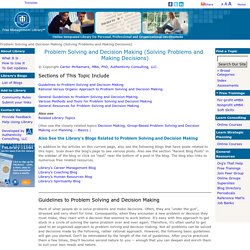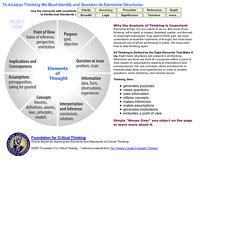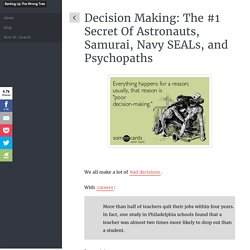

Team Problem Solving & Decision Making. Decision-Making in Groups. Problem Analysis. Problem-Solving. Six Hats. Polya's Problem Solving Techniques. The CPS Process - Creative Education Foundation. If you search the Internet for “Creative Problem Solving,” you’ll find evidence of many variations, all of which may be traced back to the work that was started by Alex Osborn in the 1940s, developed with Sid Parnes in the 1950s, and nurtured at SUNY Buffalo State and the Creative Education Foundation.

The diversity of approaches to the creative problem solving process that have developed since is a testimony to the power of the idea. While many models exist, the Creative Education Foundation focuses on an evolution of the Osborn-Parnes Creative Problem Solving process called the CPS Learner’s Model. Based on the Osborn-Parnes process, the CPS Model uses plain language and recent research. The basic structure is comprised of four stages with a total of six explicit process steps. Each step uses divergent and convergent thinking. Learner’s Model based on work of G.J. Core Principles of Creative Problem Solving. Problem Solving and Decision Making (Solving Problems and Making Decisions) © Copyright Carter McNamara, MBA, PhD, Authenticity Consulting, LLC.

Sections of This Topic Include. Critical Thinking Model 1. To Analyze Thinking We Must Identify and Question its Elemental Structures Standard: Clarityunderstandable, the meaning can be grasped Could you elaborate further?

Could you give me an example? Could you illustrate what you mean? Standard: Accuracyfree from errors or distortions, true. Time Management Tip: Use a PERT Chart. Do you have a project you need to have completed by a certain deadline?

Not sure how to go about planning it? Excellent time management and project management starts by having and writing down a clear plan. A great way to plan your projects is to create a “PERT Chart.” Agree on a time schedule. Critical Path Analysis and PERT - Project Management Skills from MindTools.com. Planning and Scheduling More Complex Projects Related variants: AOA or Activity-on-Arc Diagrams Multiple activities often feed into other activities. © iStockphoto/Cybernesco Critical Path Analysis and PERT are powerful tools that help you to schedule and manage complex projects.

They were developed in the 1950s to control large defense projects, and have been used routinely since then. Online Collaboration & Decision Making Tool. Decisions Under Uncertainty. Decision Maker. How to use The grid lets you enter options (things you'll choose between) in columns.

Just click the "add option" button, and enter the name of each option. Then you need to enter criteria that you want to rate your options on, like price, quality, frequency etc. Click the "add criteria" button and name your criteria. Each criterion needs a weight (from 1 to 10), which indicates how important it is relative to the other criteria. Example. The #1 Secret Astronauts, Samurai, Navy SEALs, and Psychopaths Can Teach You About Good Decision Making. We all make a lot of bad decisions.

With careers: More than half of teachers quit their jobs within four years. In fact, one study in Philadelphia schools found that a teacher was almost two times more likely to drop out than a student. In our jobs: A study showed that when doctors reckoned themselves “completely certain” about a diagnosis, they were wrong 40% of the time. And in our personal lives: …an estimated 61,535 tattoos were reversed in the United States in 2009. So how can we all make better decisions? It’s “arousal control.” That’s a fancy word for keeping a cool head. In their book, Decisive, Chip and Dan Heath identify short term emotion as one of the primary causes of bad decisions. Astronauts, samurai, Navy SEALs, and psychopaths. 150 Miles Above The Earth Is No Place For Panic.
Understanding the Pareto Principle (The 80/20 Rule) Originally, the Pareto Principle referred to the observation that 80% of Italy’s wealth belonged to only 20% of the population.

More generally, the Pareto Principle is the observation (not law) that most things in life are not distributed evenly. It can mean all of the following things: 20% of the input creates 80% of the result20% of the workers produce 80% of the result20% of the customers create 80% of the revenue20% of the bugs cause 80% of the crashes20% of the features cause 80% of the usageAnd on and on… But be careful when using this idea! First, there’s a common misconception that the numbers 20 and 80 must add to 100 — they don’t! Six-thinking-hats.pdf (application/pdf Object) Free Sample available, (Limited to 1 copy per customer) while stocks last.

Provides a visual image of your skills in the four cornerstones. The self-scoring section consists of 94 statements. Code: M623ASAMPLE Free Sample Available (LIMITED TO 1 PER CUSTOMER) Short Version: A Self-Made Billionaire Uses This Easy Trick for Decisions. The first chapter in Seymour Schulich’s book, Get Smarter: Life and Business Lessons, offers a decision tool that adds to the simple pro-and-con list that many of us have used to make decisions.

Schulich, a self-made billionaire, is one of Canada’s richest and best-known businessmen. I learned this tool in a practical mathematics course more than fifty years ago and have used it for virtually every major decision of my adult life. It has never let me down and it will serve you well, too. You all know the simple pro-and-con list? Act Fast, but Not Necessarily First - Frank Partnoy. Speed is killing our decisions. The crush of technology forces us to snap react.
We blink, when we should think. E-mail, social media, and 24-hour news are relentless. Our time cycle gets faster every day. OODA Loops - Decision-Making Skills Training from MindTools.com. Understanding the Decision Cycle Observation is the first step. © iStockphoto/DivaNir4a Has it ever struck you just how many military terms have become everyday terms in business-speak?
War and business are often compared and contrasted. As well as "fighting off threats" or "engaging in a price war", we talk about "gathering intelligence", "making a pre-emptive strike", and even trying to "out-maneuver" the competition. It can be fun to read books like The Art of War, written in 6th Century China by Sun Tzu, and to think about how these can be applied to business strategy. 6 types of Socratic Questions. Questioning. Collective Decisions. Making Decisions.